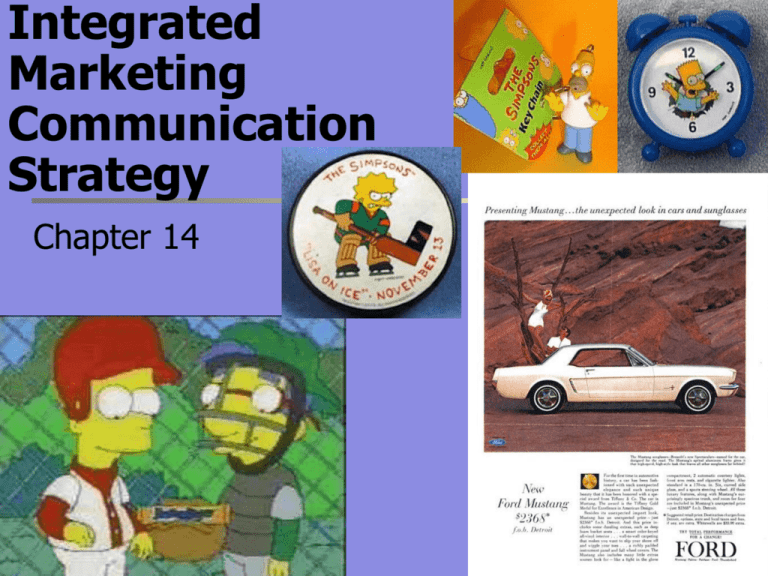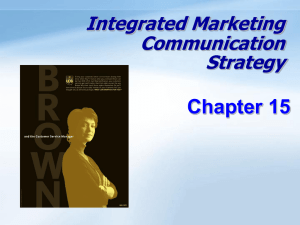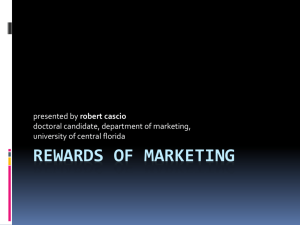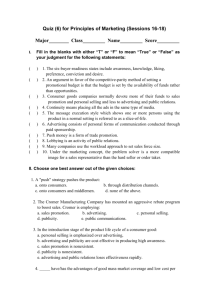Document
advertisement

Integrated Marketing Communication Strategy Chapter 14 Volvo Trucks Marketing Communication Mix or Promotion Mix Product’s Design Stores that Sell the Product Product’s Price Product’s Package The Changing Communications Environment Two Factors are Changing the Face of Today’s Marketing Communications: Improvements in Information Technology Has Led to Segmented Marketing More Narrowcasting Market Fragmentation Led to Media Fragmentation Marketers Have Shifted Away From Mass Marketing Less Broadcasting The Need for Integrated Marketing Communications With Integrated Marketing Communications (IMC), the Company Carefully Integrates and Coordinates Its Many Communications Channels to Deliver a Clear, Consistent, and Compelling Message About the Organization and Its Product or Service. (Fig. 14.1) Advertising Sales promotion Personal selling Public relations Direct marketing A View of the Communications Process Marketers View Communications as the Management of the Customer Relationship Over Time Through the Following Stages: Preselling Selling PostConsumption Consuming Elements in the Communication Process (Fig. 14.2) the sender or source of the communication Noise Encoding Noise the communication or message Noise Decoding Noise the receiver or audience Noise Key Factors in Good Communication Sellers Need to Know What Audiences They Wish to Reach and Response Desired. Sellers Must be Good at Encoding Messages That Target Audience Can Decode. Sellers Must Develop Feedback Channels to Assess Audience’s Response to Messages. Sellers Must Send Messages Through Media that Reach Target Audiences Steps in Developing Effective Communication Step 1. Identifying the Target Audience Step 2. Determining the Communication Objectives Buyer Readiness Stages This ad for the Toyota Celica may be able to cover the first three stages of the buyerreadines s s tages : aw arenes s, knowledge, and liking. There is no mention of competitors , so it does not seem to establish preference. Awareness Knowledge Liking Preference Conviction Purchase Steps in Developing Effective Communication Step 3. Designing a Message Is this ad making an emotional, rational, or moral appeal, or is it combining them? How much do the personified cows contribute to this ad? Is the ad structured to let the audience make a decision? Is this an effective ad? The same company puts lifelike statues of cows, with this slogan, into mall food courts. What makes that practice effective? Designing a Message Content The pictures and the slogan make this what type of appeal? Message Content Rational Appeals Emotional Appeals Moral Appeals Attention Format This layout, almost like a yearbook or photo album, reinforces the sentimental aspect of this advertisement. Click or press spacebar to return. Message Structure Draw Conclusions Argument Type Argument Order Interest Message Format Headline, Illustration, Copy, & Color Body Language Desire Action Steps in Developing Effective Communication Step 4. Choosing Media Personal Communication Channels Nonpersonal Communication Channels Step 5. Selecting the Message Source Step 6. Collecting Feedback Setting the Total Promotion Budget One of the Hardest Marketing Decisions Facing a Company is How Much to Spend on Promotion. Affordable Percentage of Sales Based on What the Company Can Afford Based on a Certain Percentage of Current or Forecasted Sales Objective-and-Task Competitive-Parity Based on Determining Objectives & Tasks, Then Estimating Costs Based on the Competitor’s Promotion Budget Setting the Promotion Mix Advertising Reach Many Buyers, Repeat Message Many Times, Impersonal, Expensive Personal Selling Personal Interaction, Relationship Building, Most Expensive Promo Tool Sales Promotion Wide Assortment of Tools, Rewards Quick Response, Efforts Short-Lived Public Relations Very Believable, Dramatize a Company or Product, Underutilized Direct Marketing Nonpublic, Immediate, Customized, Interactive Promotion Mix Strategies Strategy that Calls for Spending A Lot on Advertising and Consumer Promotion to Build Up (Pull) Consumer Demand. Strategy Selected Depends on: • Type of Product-Market • Product Life-Cycle Stage Strategy that Calls for Using the Salesforce and Trade Promotion to Push the Product Through the Channels. PUSH PULL Manufacturer Manufacturer Wholesaler Wholesaler Retailer Retailer Customer Customer Flow of Promotion Flow of Demand Flow of Promotion Flow of Demand Push vs. Pull Promotions Sting "Desert Rose" wasn't getting airplay, until Jaguar used the video featuring its car in an $18M advertising campaign. Integrating the Promotion Mix Analyze trends – internal and external – that can affect your company’s ability to do business. Audit the pockets of communications spending through the organization. Identify all contact points for the company and its brands. Team up in communications planning. Create compatible themes, tones, and quality across all communications media. Create performance measures that are shared by all communications elements. Appoint a director responsible for the company’s persuasive communications efforts. Socially Responsible Marketing Communication Advertising and Sales Promotion Companies must avoid false and deceptive advertising. Sellers must avoid bait-and-switch advertising. Trade promotion activities are also closely regulated. Personal Selling Salespeople must follow the rules of “fair competition”. Three-day cooling-off rule Salespeople must not disparage competitors.




